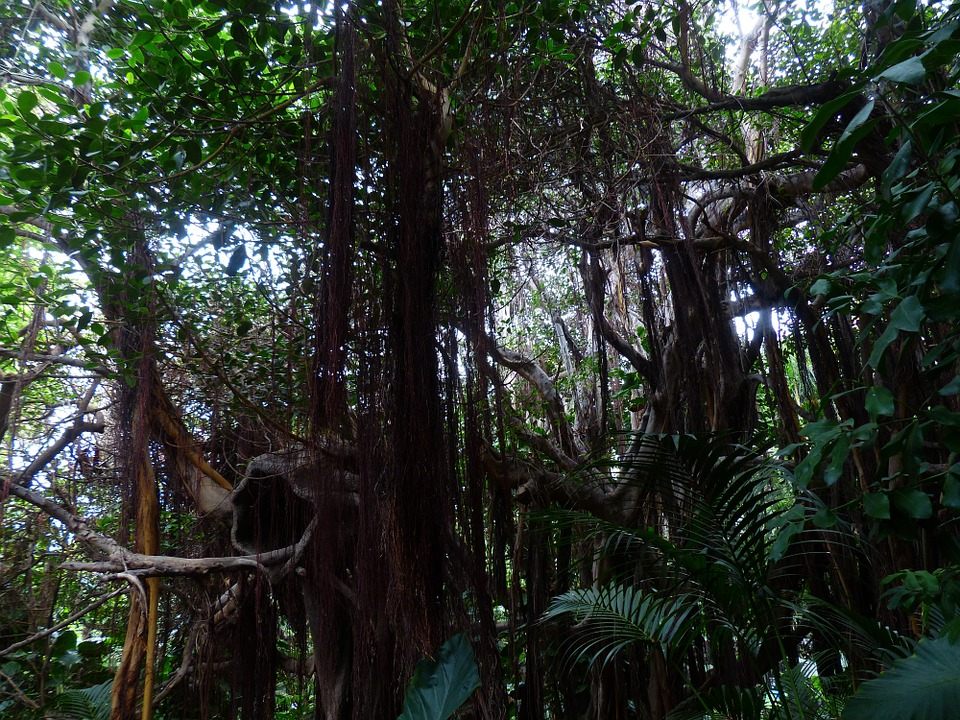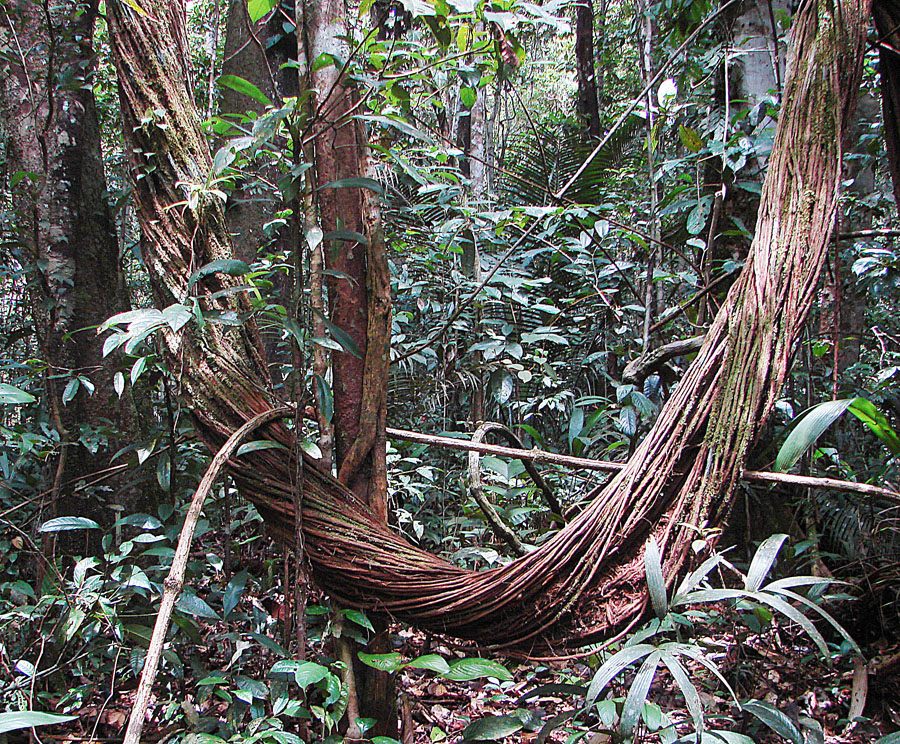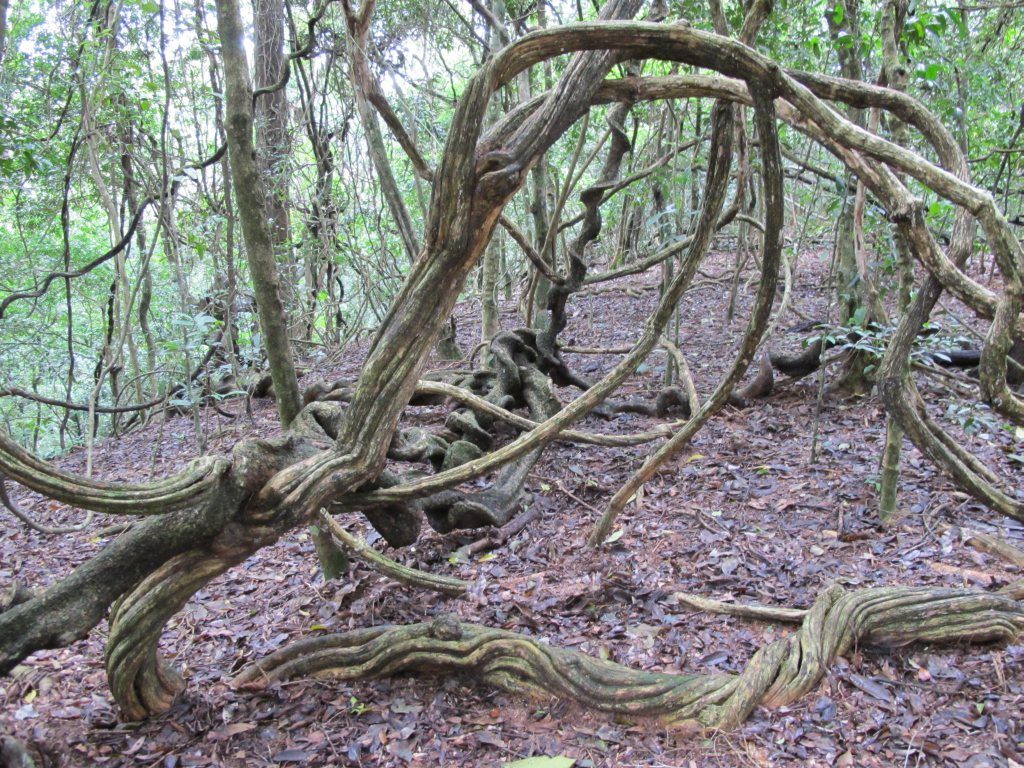Vines Are the Hipsters of Tropical Forests–Fast Increasing And Pushing Out Neighbors

A twisted liana in Hawai’i (Photo: David Eickhoff/Flickr)
Lianas, says Dr. Geertje van der Heijden, are “marvelous but strange.” A category of plant like trees or bushes, lianas are thick vines, distinguished in part by their dependence on trees for support. They can grow thick and sinewy, until they are as wide as a human head or a telephone pole, with fibers that pop from their stems like veins on the back of a hand. They can wind through a forest in a tangle, or they can fill in the canopy of trees, until it’s dense and dark. They can even be woven into bridges.
“They have these wonderful, winding stems, and they grow wherever they want,” says van der Heijden, a tropical ecologist from the University of Nottingham.
Kudzu is a type of liana; so are grape vines. Plants that grow in this way are most commonly found in tropical forests, where, for the past few decades, they have been increasing in density and crowding out trees.
They’re not unlike urban hipsters, in a way. When lianas start increasing in numbers, they make it harder for their long-established neighbors to survive and thrive in the places they’ve lived for years. And where they’re thriving, lianas may be fundamentally changing the character of the places where they’ve put down roots.

Lianas give tropical forests their character (Photo: Hans/Pixabay)
No one actually understands quite how this influx of lianas will influence tropical forests. “People have always overlooked lianas, ” says van der Heijden. Unfortunately, because we don’t know how lianas work, “We don’t know how the tropics work.”
Figuring out lianas’ secrets, though, could be crucial: tropical forests are some of the world’s most important carbon sinks, exactly the sort of locales that are needed to help keep dramatic climate change at bay. As van der Heijden and the small group of other scientists studying lianas are showing, though, as lianas increase their presence in tropical forests, those forests store less carbon.
Although the boom in liana abundance has been well-established since 2002, when the first study to show this pattern was published, it’s still a bit of a mystery why the density of lianas has been increasing. Their success could be a result of climate change, with higher levels of carbon dioxide juicing their growth. Lianas also do well when gaps appear in the forest, and since climate change could be increasing tree mortality, that could be giving lianas more opportunities to sneak in. Or it could be that lianas benefit from people’s presences in forests, since the sort of disturbances and fragmentation we tend to create benefits them, too.
But as lianas take over a particular neighborhood, they affect infrastructure, too. Lianas need trees: They are “structural parasites,” and without something sturdy to lean on and grow around, the vines don’t get very far. But the trees pay for their service–lianas can reduce an individual tree’s growth by 84 percent, and trees living with lianas around them are more likely to die. Lianas also affect the mix of trees in a forest, since they affect some trees more than others.

A bundled liana in Brazil (Photo: Dick Culbert/Wikimedia)
These facts make it sound like lianas are villains, which isn’t quite right. They are part of what gives a tropical forest its characteristic, almost claustrophobic feel. In an experiment that van der Heijden worked on in Panama, as a post-doc in Stefan Schnitzer’s lab, certain areas of forests were cleared entirely of lianas, and, she says, those parts of the forest were unusually bright–since normally the lianas block out sunlight–and felt empty. Lianas also are integral to about a quarter of a tropical forests’ biodiversity: they provide habitat and food for insects, birds, rodents, and small mammals that otherwise would have no place in the forest.
But they are different from trees. Because they mooch off the stability of trees’ woody trunks, liana stems are less dense with carbon, and the plants have more energy to produce piles of leaves. (While lianas make up just five percent of tropical forests’ total biomass, they account for 40 percent of leaf production.)
In a study published last year, in the Proceedings of the National Academy of Sciences, van der Heijden and her colleagues measured what effects those difference made for the carbon uptake of sections of forest. They compared those areas where they cleared all the lianas–eight plots that measured about 260 feet by 260 feet–with eight where the lianas were left to grow. They measured the sizes of the liana stems, the tree trunks, and other accumulated biomass for three years. At the end, they found that the presence of the lianas reduced the forest’s carbon uptake by about 75 percent each year.
That’s a dramatic difference. “We knew that there would likely be an effect,” says van der Heijden. “But that the effect was that big, we hadn’t expected. We were very surprised by its extent.”

Lianas in Sri Lanka (Photo: Nyanatusita/Wikimedia)
This particular study was conducted in Panama, in the Gigante Peninsula area of the Barro Colorado Nature Monument. It’s an area where lianas are particularly dense, which may account for the size of the impact this study measured. There’s been little enough research on lianas that it’s not clear that an effect of the same magnitude would be found in forests in Central and South America, Africa, Southeast Asia, or the east of Australia–all places where researchers are studying the ecology of lianas.
Even without knowing for sure how to quantify the impact of lianas on carbon uptake, liana researchers are certain this impact will affect calculations of how forests will behave as the climate changes–and how much carbon we can rely on them to capture from the atmosphere. Right now, a team of scientists in Belgium, led by Hans Verbeeck, is working to build the first vegetation model that accounts for liana growth. Even if the data available is not comprehensive, Verbeeck and Elizabeth Keasley wrote recently in PNAS, “the next generation of global vegetation models should include lianas at least in an implicit way.”
Right now, our understanding of the present and predictions for the future rely heavily on trees. “We know a lot about how trees work,” says van der Heijden. “But these patterns are not universal for all plant groups.” Lianas grow according to their own rules, and we’re only now understanding what those might be.



















Follow us on Twitter to get the latest on the world's hidden wonders.
Like us on Facebook to get the latest on the world's hidden wonders.
Follow us on Twitter Like us on Facebook